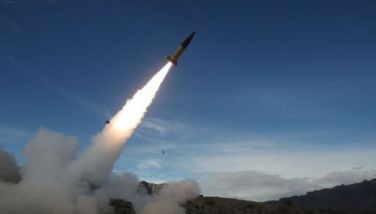Crane to clear train tracks in deadly French crash
BRETIGNY-SUR-ORGE — A powerful crane on yesterday lifted the carcass of the most damaged of four train cars that derailed, killing six people and injuring nearly 200 south of Paris in what investigators believe may have been a case of equipment failure on a line some claim is neglected.
Authorities had feared more victims would be found under the wreckage but none was discovered, said the governor of the Essonne region, Michel Fuzeau.
"We are now assured that there are no more victims," Fuzeau said after the start of the delicate operation by the 700-ton crane. The machine is to remove the cars damaged from the tracks at the small Bretigny-Sur-Orge station. On Friday, four cars slid off the tracks there as the train sped through town, which was not a stop on its journey to central France.
Human error has been ruled out by France's transport minister and the focus of the investigation is on a detached piece of metal in a switching joint on the tracks. The national rail company, SNCF, has already taken blame for Friday evening's crash, which occurred at the start of a busy holiday weekend.
"The SNCF considers itself responsible," rail company chief Guillaume Pepy said. "It is responsible for the lives of its clients."
The packed train, carrying around 385 passengers, was traveling below the speed limit at 137 kph (85 mph) when it derailed, skidded and slammed into the station platform in the small town outside the capital. It was 20 minutes into a scheduled three-hour trip to Limoges in central France.
The crane, sent from northern France, towered over the small buildings that surround the railway station. A smaller crane initially removed benches, street lamps and other urban furnishings to make place for the larger crane outside the station.
The operation is an "extraordinarily difficult technique given that we are in a train station," Pepy said. "For the moment, we don't know how long it could take." He said the operation could last through Sunday, which is the July 14 Bastille Day holiday, and into Monday, stressing the crane's operators will be careful and slow in lifting the cars.
It was not immediately clear whether the damaged cars would be lifted over buildings onto trucks as authorities had indicated — or whether the debris would be taken away by rail. There was no immediate sign that the damaged car that was lifted to check for victims had left the tracks.
Pepy, the train authority chief, said investigators found that a 10-kilogram (22-pound) piece of metal he compared to a staple between two rails in a switching system, which guides trains from one track to another, seems to have "detached itself from the rails, lifted and constituted the initial cause of the derailment."
Investigators were looking into how this happened since another train had traveled safely through the station about 30 minutes before. In addition, they were trying to determine why the train's third car was the first to derail.
Pierre Izard, another SNCF official, said the metal piece "moved into the center of the switch and in this position it prevented the normal passage of the train's wheels and it may have caused the derailment."
Although for now it appears track failure was the cause of the crash, Pepy added: "There can be no (definitive) answer in a few minutes, in a few days." He also said that all of the approximately 5,000 metal pieces on switching systems around France will be checked.
The train was about 12 miles (20 kilometers) into its 250-mile (400-kilometer) journey to Limoges.
Passengers and officials in train stations throughout France held a minute of silence at noon to commemorate the accident. Hundreds of thousands of people were expected to take trains this weekend to the coast and mountains and to see family. Summer weekends are always busy on France's extensive rail network, but this one is typically one of the busiest because of Bastille Day.
Fuzeau gave the latest casualty figures, saying that in addition to the dead, 22 people remained hospitalized, two of them in a life-threatening state. Nearly 200 people had initially been treated for injuries, either at the scene or at hospitals.
The crash was the country's deadliest in years, but Transport Minister Frederic Cuvillier said it could have been worse and praised the driver who sent out an alert quickly, preventing a pileup. However, Cuvillier acknowledged that there was some criticism that France hasn't invested enough in maintaining infrastructure.
Willy Colin of the Rail Users Association was among those who claimed the Paris-Limoges inter-city line was neglected in favor of more high-profile fast-train lines. He said on BFM-TV that trains on the line were among the oldest, calling them "garbage trains."
The transport minister said no link can immediately be made between the state of the line and the accident.
"For the moment we have no information that allows us to confirm that the dilapidation of the network was the cause of this derailment," he said on French television.
- Latest
- Trending




























